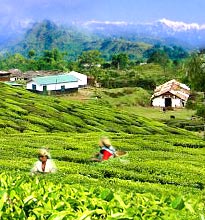 Dibrugarh is a very important tourist destination of Assam. It is also the commercial hub of the state. In addition to the numerous attractions found within Dibrugarh, there are a number of tourist places at a short distance from the city, a visit to which will definitely add to the traveler's experience. In fact, a trip to Dibrugarh without visiting these nearby exotic destinations, also known as excursions, is almost futile. Let us explore the popular excursion from Dibrugrah in detail.
Dibrugarh is a very important tourist destination of Assam. It is also the commercial hub of the state. In addition to the numerous attractions found within Dibrugarh, there are a number of tourist places at a short distance from the city, a visit to which will definitely add to the traveler's experience. In fact, a trip to Dibrugarh without visiting these nearby exotic destinations, also known as excursions, is almost futile. Let us explore the popular excursion from Dibrugrah in detail.Excursions From Dibrugarh
Namphake Village
At a distance of about 37 km from the township of Dibrugarh, on the banks of the river Burhidihing, is the Namphake village of Assam. A very beautiful Buddhist monastery is located in this area. This monastery is regarded as a meditation center, due to its unique natural settings and serene atmosphere. It also serves as a very famous tourist attraction of Assam. Apart from this, the other attractions of the area are Nong Mungchiringta (Musulinda tank), Ashoka Pillar, Pagoda, and traditional stilt houses.
Naharkatia Town
Naharkatia is a town situated in the Dibrugarh district of Assam, which is renowned for its petroleum and gas reserves. The place is especially famous for its tea gardens and is considered to be an important commercial hub of the state. At a short distance from the town lie the historic Jaypur, Tipam and Namrup. Besides this, the oldest oil pool in the state is also located here.
Dehing Namti Satra
Around 8 miles from the town of Naharkatia, on the banks of river Disang (under Sasoni mouza), is the age old Dehing Namti Satra of Assam. The satra was established by Binandashyam Gohain and was initially situated between the roads of Hologuri and Sariyahtoli, in Dibrugarh. The current location of one of the chief wings of the satra is at Namti, in Nazira.
Dinjoy Satra
This satra was first established by a prime devotee of Gopal Atadev, Srimanta Aniruddha Dev, in a village of North Lakhimpur. It was later shifted to Khutiaputa, arund the time when the Moamoria rebellion took place. During this period, Astabhuj Gosain was the head of the satra. But after his demise, this religious seat remained vacant for 14 years. Later on, Pitambar Chandra Dev was made the head. The satra fell into trouble once again at the time of Burmese invasion of India. It was finally brought to the present site of Dinjan, about 5 km from the township of Chabua, after peace returned.
Moderkhat Satra
Moderkhat Satra is actually an extension of the Dinjoy Satra and was established in the Moderkhat area of the Dibrugarh district. Chandrakantadev was the founder of this monastery. He was the brother of Sidanandadeb Dinjoy, who was the head priest of the Dinjoy Satra of Assam.
Garpara Satra
Garpara satra is older than the Dinjoy Satra itself and is situated in Rohmoria mouza, Assam. The head priest of this satra was Narimaider. In recent times, there has been a proposal of shifting the satra to a new safer location, because of soil erosion at the present site.
Raidangia Dol
Raidangia Dol is found in the Kalakhuwa area of Laruah mauza, under the Barbaruah Dev Block of Assam. Established in 700 AD, by Swargodeo Pramatta Singha, the place was originally dedicated to the worship of Lord Vishn. Later on, it became famous as Shiva Col. The dol contains relics of the powerful Ahom Kingdom. Initially, 24 statues were found engraved on the walls of the temple, but now only 14 of them are to be found. There is a large pond situated just adjacent to the temple. It is said that the dol, along with the pond and 200 pura, was given as a dowry when Swargadeo Pramatta Singha married his sister to Raidnogia Barua.
Dibru Saikhowa Park
Dibru Saikhowa National Park is situated in the Tinsukia district of Assam, only a few kilometers away from Dibrugarh. The park is the abode of a number of rare and endangered species of the animal kingdom. This includes the Royal Bengal Tiger, Clouded Leopard, Gangetic Dolphin, Barking Deer and the Asiatic Water Buffalo. The major avi fauna of the park includes Greater Adjutant Stork, Lesser Adjutant Stork, Indian Shag, Grey Heron and the White Winged Duck. The park is a very important tourist destination of the state and is generally kept open for tourists from November to April or as notified by the National Park Authority.











